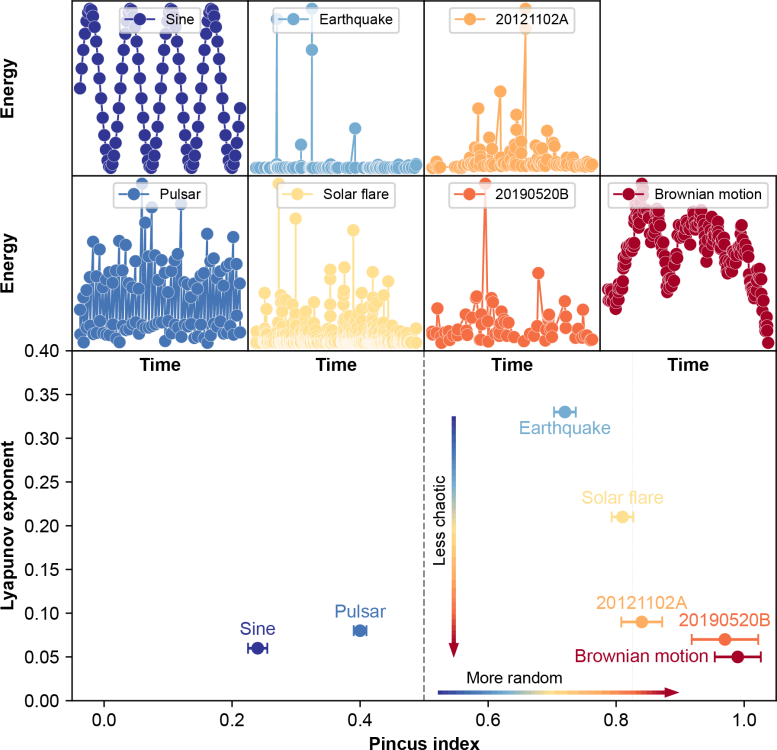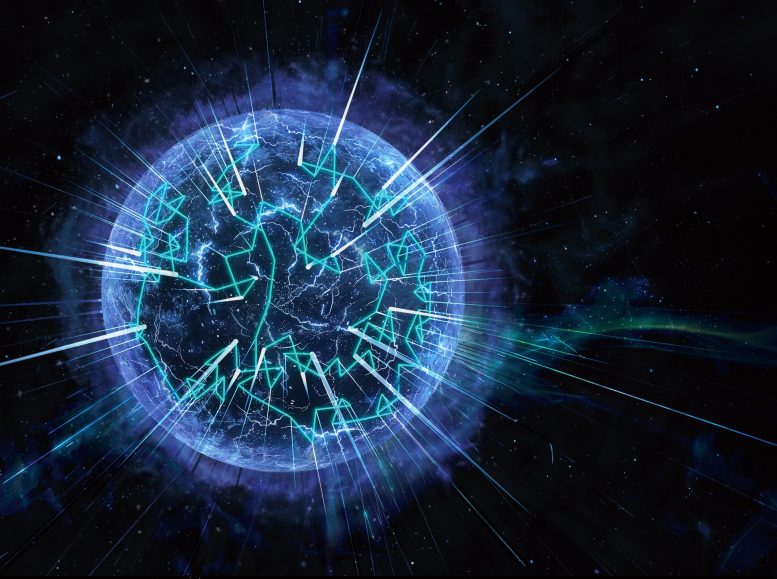The white cracks on the surface of the magnetar represent starquake activity, and the conical spikes extending from the surface represent multiple rapid bursts. The spikes vary in size, reflecting changes in burst energy. Green lines connecting bursts represent random walk paths, symbolizing the stochastic nature of fast radio burst activity. There is no direct connection between the green zigzag lines and the starquake cracks, highlighting the difference between fast radio bursts and earthquakes.Image source: © Scientific China Press
Research into fast radio bursts (FRBs) highlights their extreme energy output and mysterious nature. Recent studies using innovative methods to analyze FRBs have shown that FRBs are caused by multiple emission mechanisms, adding to the complexity of understanding their origins.
Fast Radio Bursts (FRBs) represent the most powerful radio explosions in the universe, releasing enough energy in just a thousandth of a second to power global human society for a trillion years. Since their first discovery in 2007, FRBs have attracted widespread attention, culminating in the 2023 Shaw Prize in Astronomy. The origin of these extreme cosmic bursts is unknown and is one of the most mysterious phenomena in astronomy and physics.
The causal relationship shows that the size of the FRB source should be smaller than c·dt, where c is the speed of light and dt is the duration of the event. For a typical 1 millisecond burst, this would mean a region of less than 300 kilometers, meaning that a dense object such as a neutron star or black hole is the engine of the FRB. Fast spins are observed in most compact objects, leading to the expectation of periodic bursts of repeated fast radio bursts. However, extensive searches for periodicity on scales from milliseconds to seconds have failed, prompting a re-evaluation of the emission mechanisms of fast radio bursts.

The top and middle panels present the sequence of events in time-energy space for these sources. The color changes from blue to red, meaning increased randomness. In the bottom panel, FRBs are clustered with Brownian motion toward highly random but less chaotic regions in random chaotic phase space, unlike earthquakes and solar flares, both of which are more chaotic but less random than FRBs. Low.Image source: © Scientific China Press
A team led by Professor Li Di from the National Astronomical Observatory of the Chinese Academy of Sciences proposed a new method to characterize the behavior of fast radio bursts in the time-energy dual-variable phase space. They used the generalized “Pincus Index” and “Lyapunov Index” to quantify randomness and chaos respectively, and successfully placed FRBs systematically in the context of other common physical events such as pulsars, earthquakes, and solar flares. Down.
Randomness and chaos both lead to unpredictability, but they are distinct. The unpredictability of a random sequence remains constant over time, just like rolling dice—the outcome of each roll has no relation to the previous one. In chaotic systems, unpredictability grows exponentially over time. For example, anyone can predict the weather a few seconds into the future by looking up and around, but accurately predicting long-term weather remains a challenge for humans.
The research team found that fast radio bursts roam in the energy-time phase space and are less chaotic but more random than earthquakes and solar flares. The apparent randomness of FRB emission suggests a combination of multiple emission mechanisms or locations. This study establishes a new framework for quantifying fast radio bursts, bringing us closer to finally revealing the origins of these violent cosmic explosions: Who is rolling the cosmic dice?
Reference: “The arrival time and energy of fast radio bursts travel through the time-energy binary space like Brownian motion” by Yong-Kun Chang, Di Li, Yi Feng, Pei Wang, Chen-Hui Niu, Shi Dai, Ju -Mei Yao and Cai Chaowei, February 9, 2024 Chinese Science Bulletin.
DOI: 10.1016/j.scib.2024.02.010
#Clues #cosmic #chaos #fast #radio #bursts
Image Source : scitechdaily.com
